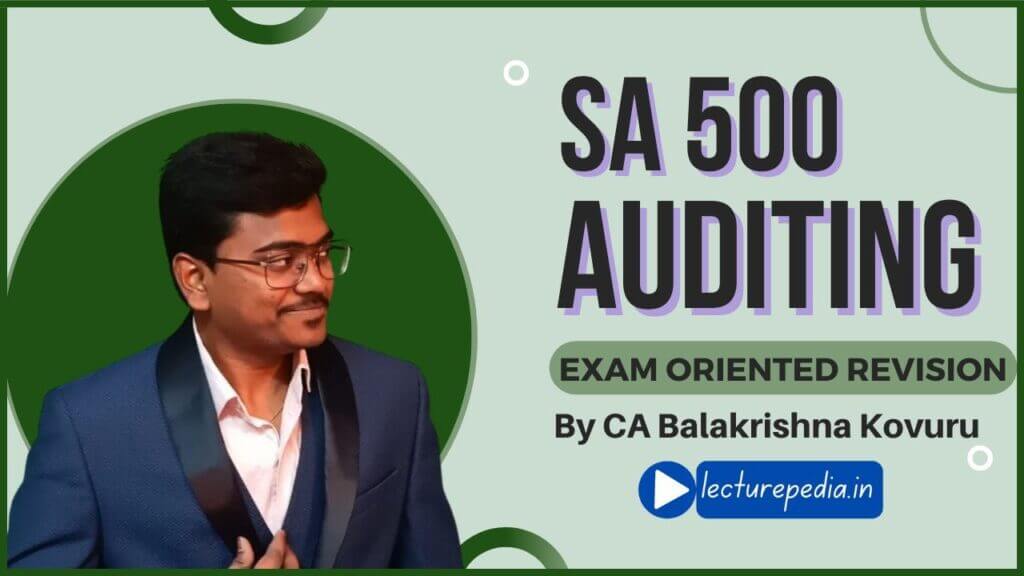Objective of SA 500
The objective of the auditor as per SA 500 Audit Evidence is to design and perform audit procedures in such a way as to enable the auditor to obtain sufficient appropriate audit evidence to be able to draw reasonable conclusions on which to base the auditor’s opinion.
Definitions used in SA 500
1) Audit evidence – Information used by the auditor in arriving at the conclusions on which the auditor’s opinion is based. Audit evidence includes both information contained in the accounting records underlying the financial statements and other information.
2) Sufficiency (of audit evidence) – The measure of the quantity of audit evidence. The quantity of the audit evidence needed is affected by the auditor’s assessment of the risks of material misstatement and also by the quality of such audit evidence.
3) Appropriateness (of audit evidence) – The measure of the quality of audit evidence; that is, its relevance and its reliability in providing support for the conclusions on which the auditor’s opinion is based.
Audit procedures/Methods to obtain Audit evidence
Inspection:- Inspection involves examining records or documents or a physical examination of an asset. An example of inspection used as a test of controls is inspection of records for evidence of authorization.
Observation:- Observation consists of looking at a process or procedure being performed by others, for example, the auditor’s observation of inventory counting by the entity’s personnel,
External Confirmation:- An external confirmation represents audit evidence obtained by the auditor as a direct written response to the auditor from a third party (the confirming party), in paper form, or by electronic or other medium.
Recalculation:- Recalculation consists of checking the mathematical accuracy of documents or records. Recalculation may be performed manually or electronically.
Reperformance:- Reperformance involves the auditor’s independent execution of procedures or controls that were originally performed as part of the entity’s internal control.
Analytical Procedures:- Analytical procedures consist of evaluations of financial information made by a study of plausible relationships among both financial and non-financial data.
Inquiry:- Inquiry consists of seeking information of knowledgeable persons, both financial and non- financial, within the entity or outside the entity. Inquiry is used extensively throughout the audit in addition to other audit procedures. Inquiries may range from formal written inquiries to informal oral inquiries.
Using the work of managements expert
When information to be used as audit evidence has been prepared using the work of a management’s expert, the auditor shall
1) Evaluate the competence, capabilities and objectivity of that expert Information regarding the competence, capabilities and objectivity of a management’s expert may come from a variety of sources, such as:
a) Personal experience with previous work of that expert.
b) Discussions with that expert.
c) Discussions with others who are familiar with that expert’s work.
d) Knowledge of that expert’s qualifications, membership of a professional body or industry association, license to practice, or other forms of external recognition.
e) Published papers or books written by that expert.
f) An auditor’s expert, if any, who assists the auditor in obtaining sufficient appropriate audit evidence with respect to information produced by the management’s expert.
2) Obtain an understanding of the work of that expert which includes following
a) an understanding of the relevant field of expertise
b) Whether that expert’s field has areas of specialty within it that are relevant to the audit
c) Whether any professional or other standards, and regulatory or legal requirements apply.
d) What assumptions and methods are used by the management’s expert, and whether they are generally accepted within that expert’s field and appropriate for financial reporting purposes.
e) The nature of internal and external data or information the auditor’s expert uses.
3) Evaluate the appropriateness of that expert’s work as audit evidence for the relevant assertion. Considerations when evaluating the appropriateness of the management’s expert’s work as audit evidence for the relevant assertion may include:
a) The relevance and reasonableness of that expert’s findings or conclusions, their consistency with other audit evidence, and whether they have been appropriately reflected in the financial statements;
b) If that expert’s work involves use of significant assumptions and methods, the relevance and reasonableness of those assumptions and methods; and
c) If that expert’s work involves significant use of source data, the relevance, completeness, and accuracy of that source data.

